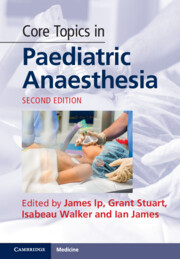Book contents
- Core Topics in Paediatric Anaesthesia
- Core Topics in Paediatric Anaesthesia
- Copyright page
- Contents
- Contributors
- Preface
- Chapter 1 Anatomical and Physiological Issues Affecting Anaesthesia in Neonates and Young Children
- Chapter 2 Pharmacological Issues Affecting Anaesthesia in Neonates and Young Children
- Chapter 3 Developmental Psychology and Communicating with Children and Families
- Chapter 4 The Law and Paediatric Anaesthesia
- Chapter 5 Safeguarding Children and Its Implications for the Anaesthetist
- Chapter 6 Paediatric Anaesthesia in Non-specialist Centres
- Chapter 7 Preoperative Assessment for Paediatric Anaesthesia
- Chapter 8 Congenital and Inherited Disorders Affecting Anaesthesia in Children
- Chapter 9 Day-Case Anaesthesia in Children
- Chapter 10 General Principles of Safe Anaesthesia in Children
- Chapter 11 Equipment and Monitoring in Paediatric Anaesthesia
- Chapter 12 Vascular Access in Children
- Chapter 13 Perioperative Fluid Management in Children
- Chapter 14 Total Intravenous Anaesthesia in Children
- Chapter 15 Regional Anaesthesia in Children
- Chapter 16 Sedation for Procedures in Children
- Chapter 17 Perioperative Analgesia in Children
- Chapter 18 Neonatal Anaesthesia
- Chapter 19 The Premature and Ex-Premature Infant
- Chapter 20 Anaesthesia for General Surgery in Children
- Chapter 21 Anaesthesia for ENT Surgery in Children
- Chapter 22 The Compromised Paediatric Airway
- Chapter 23 Anaesthesia for Cleft Lip and Palate Surgery in Children
- Chapter 24 Anaesthesia for Dental and Maxillofacial Surgery in Children
- Chapter 25 Anaesthesia for Craniofacial Surgery in Children
- Chapter 26 Anaesthesia for Neurosurgery in Children
- Chapter 27 Anaesthesia for Ophthalmic Surgery in Children
- Chapter 28 Anaesthesia for Plastic Surgery in Children
- Chapter 29 Anaesthesia for Orthopaedic and Scoliosis Surgery in Children
- Chapter 30 Anaesthesia for Thoracic Surgery in Children
- Chapter 31 Anaesthesia for Cardiac Surgery in Children
- Chapter 32 Anaesthesia for Cardiac Catheterisation and Other Investigative Procedures in Children
- Chapter 33 Anaesthesia for Children with Cardiac Disease Undergoing Non-cardiac Surgery
- Chapter 34 Anaesthesia for Urological Surgery in Children
- Chapter 35 Anaesthesia for Hepatobiliary Surgery, Including Transplantation, in Children
- Chapter 36 Anaesthesia for Radiology and Interventional Radiology in Children
- Chapter 37 Anaesthesia for Oncology and Other Medical Procedures in Children
- Chapter 38 Principles of Paediatric Resuscitation
- Chapter 39 Trauma in Children
- Chapter 40 Burns in Children
- Chapter 41 Principles of Paediatric Intensive Care
- Chapter 42 Stabilisation and Transport of the Critically Ill Child
- Index
- References
Chapter 17 - Perioperative Analgesia in Children
Published online by Cambridge University Press: 06 February 2025
- Core Topics in Paediatric Anaesthesia
- Core Topics in Paediatric Anaesthesia
- Copyright page
- Contents
- Contributors
- Preface
- Chapter 1 Anatomical and Physiological Issues Affecting Anaesthesia in Neonates and Young Children
- Chapter 2 Pharmacological Issues Affecting Anaesthesia in Neonates and Young Children
- Chapter 3 Developmental Psychology and Communicating with Children and Families
- Chapter 4 The Law and Paediatric Anaesthesia
- Chapter 5 Safeguarding Children and Its Implications for the Anaesthetist
- Chapter 6 Paediatric Anaesthesia in Non-specialist Centres
- Chapter 7 Preoperative Assessment for Paediatric Anaesthesia
- Chapter 8 Congenital and Inherited Disorders Affecting Anaesthesia in Children
- Chapter 9 Day-Case Anaesthesia in Children
- Chapter 10 General Principles of Safe Anaesthesia in Children
- Chapter 11 Equipment and Monitoring in Paediatric Anaesthesia
- Chapter 12 Vascular Access in Children
- Chapter 13 Perioperative Fluid Management in Children
- Chapter 14 Total Intravenous Anaesthesia in Children
- Chapter 15 Regional Anaesthesia in Children
- Chapter 16 Sedation for Procedures in Children
- Chapter 17 Perioperative Analgesia in Children
- Chapter 18 Neonatal Anaesthesia
- Chapter 19 The Premature and Ex-Premature Infant
- Chapter 20 Anaesthesia for General Surgery in Children
- Chapter 21 Anaesthesia for ENT Surgery in Children
- Chapter 22 The Compromised Paediatric Airway
- Chapter 23 Anaesthesia for Cleft Lip and Palate Surgery in Children
- Chapter 24 Anaesthesia for Dental and Maxillofacial Surgery in Children
- Chapter 25 Anaesthesia for Craniofacial Surgery in Children
- Chapter 26 Anaesthesia for Neurosurgery in Children
- Chapter 27 Anaesthesia for Ophthalmic Surgery in Children
- Chapter 28 Anaesthesia for Plastic Surgery in Children
- Chapter 29 Anaesthesia for Orthopaedic and Scoliosis Surgery in Children
- Chapter 30 Anaesthesia for Thoracic Surgery in Children
- Chapter 31 Anaesthesia for Cardiac Surgery in Children
- Chapter 32 Anaesthesia for Cardiac Catheterisation and Other Investigative Procedures in Children
- Chapter 33 Anaesthesia for Children with Cardiac Disease Undergoing Non-cardiac Surgery
- Chapter 34 Anaesthesia for Urological Surgery in Children
- Chapter 35 Anaesthesia for Hepatobiliary Surgery, Including Transplantation, in Children
- Chapter 36 Anaesthesia for Radiology and Interventional Radiology in Children
- Chapter 37 Anaesthesia for Oncology and Other Medical Procedures in Children
- Chapter 38 Principles of Paediatric Resuscitation
- Chapter 39 Trauma in Children
- Chapter 40 Burns in Children
- Chapter 41 Principles of Paediatric Intensive Care
- Chapter 42 Stabilisation and Transport of the Critically Ill Child
- Index
- References
Summary
Pain following surgery continues to be a common experience in children, despite advances in acute pain management. The effective and safe management of pain in children of all ages requires significant knowledge of the biopsychosocial experience of pain and strategies available for its management. Numerous factors can influence the success of analgesic treatment: Developmental age has a profound effect on both the processing of nociceptive information and the response to analgesia; the pharmacology of all drugs is age and size dependent, requiring appropriate dosage adjustments; and communication with the very young or those with developmental delay can influence the ability to assess pain and monitor the response to treatment.
- Type
- Chapter
- Information
- Core Topics in Paediatric Anaesthesia , pp. 197 - 206Publisher: Cambridge University PressPrint publication year: 2025

